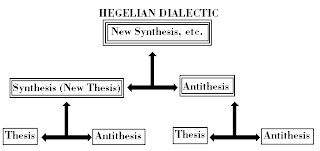Hegel is known by historians as the person who theorized a dialectical view of history.
Marx turned Hegel's ideas upside down and proposed dialectical materialism.
Thesis -- Antithesis -- Synthesis (which becomes the new Thesis)
The following is quoted from "Dialectics" in Wikipedia:
Karl Marx and Friedrich Engels believed Hegel was "standing on his head," and endeavoured to put him back on his feet, ridding Hegel's logic of its orientation towards philosophical idealism, and conceiving what is now known as materialist or Marxist dialectics. This is what Marx had to say about the difference between Hegel's dialectics and his own:Iran, as Satrapi explains it, goes from thesis to antithesis every few years. Her own passions similarly go from God to revolutionary fervor, from passion for the government to passion against the government, and so on. This picture shows herself and her world:
My dialectic method is not only different from the Hegelian, but is its direct opposite. To Hegel, the life-process of the human brain, i.e. the process of thinking, which, under the name of 'the Idea,' he even transforms into an independent subject, is the demiurgos of the real world, and the real world is only the external, phenomenal form of 'the Idea.' With me, on the contrary, the ideal is nothing else than the material world reflected by the human mind, and translated into forms of thought." (Capital, Volume 1, Moscow, 1970, p. 29).
Ironically, dialectical materialism is the structural and theoretical underpinning of both Persepolis and "Saboteur."



Dear mdp,
ReplyDeleteThere is a website dedicated to the further development of Marxian dialectics that may interest you: www.dialectics.org.
They have developed an 'arithmetic of dialectics', with the algebra of which they have developed many 'dialectical-mathematical models' that reconstruct past history, and that generate predictions of the future.
They apply two different generic dialectical interpretations of their dialectical algebra, which coincide only for the first three terms -- thesis + antithesis + synthesis. Here are their versions of the first 8 or 9 terms for each of these two generic dialectical interpretations of their algebra.
'Dyadic Seldon Function' -- thesis^(2^3) = thesis^8 =
first thesis + first antithesis + first full synthesis + second antithesis + first partial synthesis + second partial synthesis + second full synthesis + third antithesis.
'Triadic Seldon Function' -- thesis^(3^3) = thesis^9 =
first thesis + first full antithesis + first full synthesis + first partial antithesis + second partial antithesis + second full antithesis + first partial synthesis + second partial synthesis + second full synthesis.
Related material can be found at www.adventures-in-dialectics.org
Regards,
Miguel
Correction: Second equation should be -- thesis^(3^2) = thesis^9 = ...
Delete